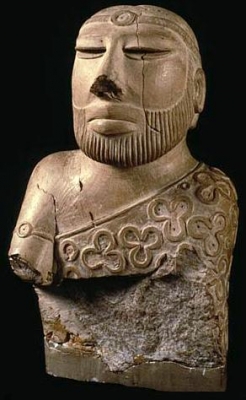
Princess Enheduanna, daughter of the great king Sargon of Akkad in Mesopotamia, paced about impatient for the latest shipment from Meluha. She wanted a new dress made of ultra-fine cotton, printed with a striking pattern of blue, red and yellow, or maybe a slightly thicker cotton, striped blue and cream. She had heard they even had this really fine soft wool that you could actually draw through a ring. But their jewellery was simply the best! She had her heart set on a long necklace of carved carnelian and gold.
Chic clothes
Meluha was what the Mespotamians called the ancient Harappan civilization. So how did ancient Harappans dress?
The most common fabric was, of course cotton, which was native to India. It was woven thick, or fine and gauze-like. It was used in its natural colour, or dyed in many shades – a rich blue with indigo, red with the madder plant, or yellow with turmeric. Patterns were often created by weaving – fabric woven in coloured solid stripes, or with different colours in warp and weft, creating a shimmery look like the still used Khes material in Punjab. The fabrics were also printed in patterns using many colours, similar to Ajrakh printing in Gujarat today. The shawl in the famous statue of the Priest King is an example of fabric printed in such a pattern. Clothes could be embroidered or studded with buttons made of terracotta, ivory, and if you were rich, gold sequins!
They also used wool, both coarser varieties from sheep, and finer varieties similar to Pashmina and Shatoosh. Native Indian varieties of silk like Tussar have been found, as have hemp and jute fibres. Most garments seem to have been unstitched and draped in various patterns, similar to those worn in much of India today.
Woman wore short knee-length skirts, or longer ones that reached their calves. Men wore something which looked sort of like a dhoti. Some would also drape a fabric over their upper halves. Men wore turbans or conical caps.
Even animals were dressed well – often covered with blankets to protect them from the cold or insects. Painted deigns on some terracotta figurines suggest that some of these blankets may have been embroidered or woven with patterns. Think of the brightly festooned camels and elephants you see in India today!
Seem like a lot of what we do today harks back to the Harappans!
Hip Hairdos
Woman had very elaborate hair styles – with braids, buns, ringlets or left loose. They also used really small beads (1 man) to bead up their hair (like an afro possibly!) They would use kajal made from antimony, face powders and other cosmetics and used burnished copper mirrors to view themselves. Mehendi was also grown.
Jazzy jewellery
The Indian passion for jewellery is a long standing one it seems, as both Harappan men and women wore a lot of it! Men wore head bands, bead necklaces and bangles, while women draped themselves with bangles, earrings, rings, anklets, belts, pendants, chokers and necklaces of all lengths…phew!
The jewellery was made of gold, silver, ivory, gemstones, or if you were not so rich, shell, bones or even mud (terracotta)! Hundreds of clay bangles have been found – painted in different colours. They would often be worn to cover the entire arm, like the famous dancing girl statue, and still worn by some tribal people in Rajasthan.
One of the crafts that the Indus people had really mastered was that of bead-making. The beads were made from semiprecious stones such as steatite, agate, camelian, lapis lazuli, other materials such as shell and terracotta, and even some from gold, silver and copper.
Bead-making was time consuming as the drilling and polishing had to be done carefully by hand (no electricity!) and people who were able to afford these beads would have been well-off. In fact, a belt was found with thirty six very long camelian bedas, each of which would have taken a skilled craftsman about two weeks to make. So thirty six beads represent the full time work of more than a year, and we can be sure that the owner of the belt would have been very rich indeed. Imitation goods is by no means a modern business, and for the not so well off, the Indus Valley bead-makers also produced imitation beads out of baked terracotta and painted them red to resemble camelian beads.
The Harappas acquired gold by trade from Mesopotamia, by panning it from the banks of the Indus River, or from the mines in Kolar in South India, by bartering with the local Neolithic tribal people. In fact, the tribal people may have been slightly short-changed in these transactions as cheao steatite paste beads, which were made from the waste stone powder generated while seal making, have been found near this region. Of course all these fabulous Indian products were exported as far as Mesopotamia!
Picture Credit : Google
